|
|
 |
Canadian Historic Sites: Occasional Papers in Archaeology and History No. 16
The Battle of the Restigouche
by Judith Beattle and Bernard Pothier
The Battle
The Louisbourg squadron, under Byron, made contact with the French on
22 June when the Fame was anchored alone off Miguasha Point (most
of the squadron having been dispersed by fog). Four of its boats
captured an armed reconnaissance schooner which the French had
previously taken as a prize.1
Failing instructions from Montreal, Giraudais was forced —
albeit reluctantly — to initiate on his own the defense of a
position in which he unequivocally held strategic and tactical
advantages. His forces comprised the Machault, 26 guns (but only
14 mounted on 8 July, the day of the final engagement); the
Bienfaisant, 16 guns mounted: the Marquis do Malauze, 12
guns mounted; six English ships captured in the Gulf of St. Lawrence,
and 25 to 30 Acadian sloops and schooners from the Miramichi and
elsewhere whose crews had joined the French when they learned of the fleet's
arrival in the Restigouche. In terms of manpower, the French had 200
regular Troupes de la Marine (infantry under the authority of the Navy
Department) under D'Angeac; 300 Acadians capable of bearing arms, "tous
adroits mais paresseux et indépendants s'ils ne sont
gouvernés,"2 and 250 Micmacs. Nevertheless, the capture of
the reconnaissance schooner marked the inauspicious beginning of a
particularly inept military effort by the French.
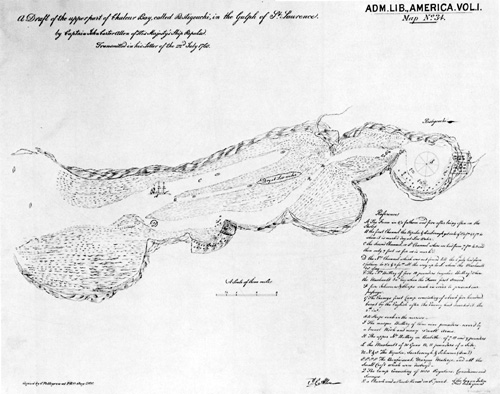
3 "A Draft of the upper part of Chaleur Bay, called Restigouchi, in
the Gulph of St. Lawrence, by Captain John Carter Allen of His Majesty's
Ship Repulse. Transmitted in his letter of 22d July 1760."
A The Fame. . . .
B the first Channel. . . .
C the Second Channel, or So. Channel. . . .
D the No. Channel. . . .
E The No. Battery. . . .
F five Schooners & Sloops sunk . . . to prevent our passage.
G The Enemys first Camp. . . .
HH Sloops sunk in the narrows.
I The masque battery. . . .
K The upper No. Battery en Barbette. . . .
L The Machault. . . .
M, N, & O. The Repulse, Scarborough, & Schooner. . . .
P.P.P.P. The Bienfaisant, Marque Malorge, and all the Small Craft which were destroy'd.
Q The Camp consisting of 1000 Regulars, Canadians and Savages.
R a Church and a Priests House on So. point.
S the bay an Intire Flat boats ground.
A Scale of three miles."
(Public Archives of Canada.) (click on image for a PDF version)
|
23 June
Byron weighed anchor on the morning of 23 June and set out for the
head of the bay in search of the enemy, but the vagaries of the
unfamiliar shallow channel soon compelled him to abandon the cumbersome
Fame. Resuming his navigation in the Fame's boats, he soon
"saw sevl ships & vessls at anchor above them about 2 leag near a
point of land (on the Northern shore) . . . a frigate . . . 2 others
seemed to be Merchant or Storeships the others sloops and schooners in
all 10 or 12 sail. . . ."3
24 June
At dawn the next day Byron dispatched two boats to make further
soundings, but within two hours they were compelled to return to the
flagship with several French boats in pursuit.
On 24 June Giraudais set his men to the rapid completion of the
battery, being built en barbette, that he had begun on the north shore
at Pointe à la Batterie. He transferred four 12-pounders and one
6-pounder from the Machault, his flagship, to the battery and
appointed his second in-command, Donat do la Garde,4 to
command the position. As a mobile supplement to the shore battery,
Giraudais retained the Machault in readiness in the channel,
close behind a chain of small sloops and schooners which he scuttled
one-half cannon-shot below the battery.
The 60 men and seven women taken prisoner on their way to Quebec City
in May, although "well used before the English ships appeared," were
now packed into the hold of a small schooner for security reasons. According to the
moving testimony of the prisoners, they were henceforth
without air, without light, strongly guarded by a party of
soldiers, under the cannon of the battery; our cloaths and beds taken
from us; we had not room to stretch ourselves . . . [with] very
little provisions and only brackish water to drink.
...5
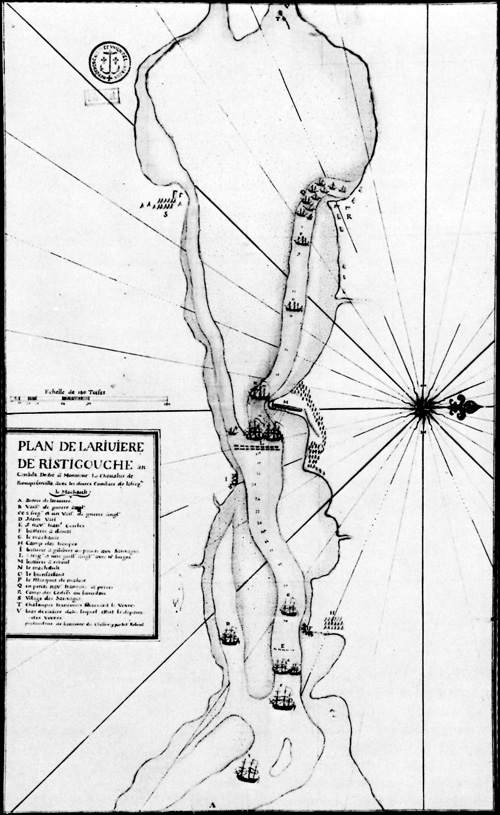
4 "Plan de lariviere de Ristigouche au Canàda. Dedié a Monsieur le
Chevalier de Bouquinville, avec les divers Combats de lafreg[ate] le
Machault
A antrée de larviere
B Vaiss[eaux] de guerre angl[ais]
CC 2 freg[ates] et un Vais[seau] de guerre angl[ais]
D Idem Vais[seau]
E 5 nav[ires] fran[çois] coules.
G batterie à donat
G le machault
H Camp des troupes
I batterie a gilibert ou pointe aux Sauvages
L 2 freg[ates] et une [goélette] angl[ais] avec 16 berges.
M batterie a reboul
N le machault
O le bienfaisant
P Le Marquis de malose
Q 10 petits nav[ires] françois et prises
R Camp des Cadies ou bourdon
S Vilage des Sauvages
T Chaloupes françoises Chariant le Vivres
V bras de rivière dans lequel ettoit le depaux des Vivres.
profondeur de bassemer en Chiffres. par le Sr Reboul,
Echelle de 180 Toises."
(Bibliothéque Nationale/Ministère de la Défense [Marine],
from a copy in the Public Archives of Canada.) (click on image for a PDF version)
|
25 June
On 25 June the Fame weighed anchor and attempted to move
closer to the head of the bay; however, at low water, at noon, it went
aground "on a patch of mud,"6 "where I thought we never
should have got off again."7 It did get off, but only after
nine or ten hours of arduous effort and jettisoning "one of her anchors
for the present,"8 and with the help of the schooner
recaptured earlier off Miguasha Point.
It is difficult to comprehend Giraudais's failure to capitalize on
the definite tactical advantage of having his adversary aground on the
shoals. Decisive action by the French on 25 June might have
altered the outcome of the encounter. However, the French commander
was not altogether unmindful of his advantage. As Byron learned later,
Giraudais has actually contemplated sending a boarding party to the
Fame,9 but had changed his mind when he perceived the
man-of-war to be a fully armed two-decker.
The Fame's admittedly formidable firepower notwithstanding,
the French held enough of the classic advantages of a war situation to
virtually guarantee their success; they enjoyed adequate manpower, the
advantages of a secure defensive position, mobility both on land and on
water, surprise, and for at least two hours before the Fame was
released from the shoals, darkness. Their only serious disadvantage,
albeit an essential one, was the low morale of both officers and men.
Disheartened by the events both in Europe and North America in the
previous two years which undermined France's position, neither
Giraudais nor D'Angeac, any more than their subalterns, possessed the
energy or bold offensive spirit which, combined with their physical
advantages, might have led to a decisive French victory on the
Restigouche in 1760.
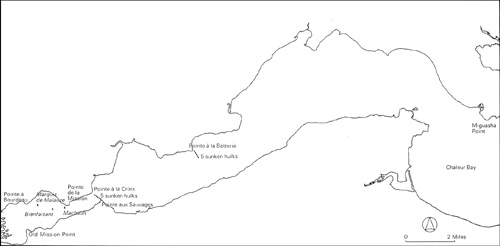
5 Restigouche River, showing the location of land and
water sites.
(Map of S. Epps.) (click on image for a PDF version)
|
26 June
On 26 June the rest of the English squadron came into view off
Miguasha Point. While the captains of the ships of the line, the
Achilles and the Dosetshire, realized they were facing an
unknown channel and prudently anchored east of the point, the captains
of the frigates, the Scarborough and the Repulse, at first
took the Fame to be French and endeavoured to get up to it. The
enthusiasm of both Captain Scot and Captain Alien was exceeded only by
their brash disregard of the navigational realities under which they
were to labour. Both frigates ran aground and although the
Scarborough was soon released thanks to assistance from the
Fame, the Repulse was forced to spend the night on the
shoals.10
27 June
His squadron at full complement now, on 27 June Byron ordered the
Fame's boats and the captured schooner to search for the elusive
channel. The Scarborough, the Repulse and the Fame
cautiously took up the rear.11 The most serious disadvantage
of the English, given the low morale of the French, was the hazardous
navigation. The channel ran very close to the north shore and was
therefore exposed to the French guns and musketry. It was also, as Byron
put it, so narrow there was "no room for a ship to
swing."12
28 June
When, on 23 June, the captured schooner went aground in less than a
fathom,13 it was clear that the English had unwittingly
penetrated into a cul-de-sac. At the same time, the Repulse and
the Scarborough lay aground within range of the French guns at
Pointe à la Batterie. Giraudais gave the order to open fire, but the
French action was limited to a rather passive and half-hearted effort
and their fire caused little real damage to the English. Nevertheless,
coupled with musketry from a detachment of regulars, Acadians and
Miemacs hidden in the surrounding woods, it harrassed the English in
their efforts to get the ships afloat. However, the powerful artillery
of the Fame was brought to bear on the French position as a cover
for the grounded frigates and by evening the French musketry was
effectively dispersed.
Giraudais reverted to the defensive once again, ordering the
Marquis de Malauze and the Bienfaisant as far upstream in
the Restigouche as possible in order to protect their
cargoes.14 He brought the Machault to the mouth of the
river only slightly beyond the range of the English guns, later
explaining; "Javois medité de resté avec ma fregatte Pour Soutenir la
Batterie mais la force de l'Ennemis Estant trop Supérieure Maurois
Empeché de regoindre tous les Batiments que Javois fait
monter.15
As a further precaution, Giraudais ordered the English prisoners
transferred from their prison aboard a schooner to the more secure hold
of the Machault where they apparently underwent more severe
treatment than previously.
The sailors were put into irons, and the captains and merchants
had an old sail to lie on, spread on a row of hogsheads. Our allowance
was bread and wine with two ounces of pork per day; but, thank God, our
appetites were not very keen; and if we complained that we were stifled
with stench and heat, and eat up with vermin, they silenced us with
saying, "Well, you shall go on shore under a guard of Indians..." after
telling us the savages had sworn they would scalp us every soul; they
told us also, that, if we made the least noise, they would point four
cannon into the hold and sink the vessel, or burn us like a parcel of
rats.16
The search for a navigable channel remained Byron's essential first
objective. He might well have dispensed with this exercise given the
inability of the French to undertake a spirited defensive effort.
Indeed, had he been willing to depart from the classical norm. Byron
could well have landed a party, routed the French on shore, and then
proceeded to harass the enemy squadron unimpeded.
The fact that even Byron's captured schooner, of low draft, had run
aground while the Machault had retreated upriver with relative
ease was sufficient indication that considerable further effort was
required before a passage could be found. Thus the soundings continued
and during the night of 28-29 June a new and apparently promising
channel was discovered close to the south shore of the Restigouche.
29 June
Byron immediately ordered the Repulse and the
Scarborough to swing back and attempt the new passage, but
further sounding soon belied his premature optimism. The passage, the
"So[uth] channel" of the Allen map (or, more accurately, "le faux chanal
du Sud" as Giraudais called it17), was not a channel at all,
but another cul-de-sac which from an impressive seven fathoms had
quickly fallen to nine feet before running into mud flats at low
water.
With the transfer of English efforts to the south channel on 29 June,
the Repulse and the Scarborough fell beyond the range of
the French guns at Pointe à la Batterie;18 however, the
battery remained within range of the powerful guns of the Fame
which enjoyed the further and more significant advantage of firing at
the unprotected French flank.19 Although the French at first
returned the Fame's fire, they were overwhelmed within a few
days.
2 July
By noon on 2 July, the Fame had smashed the easternmost French
gun and a short time later the French began "making off from
thence."20 Their retreat was premeditated and orderly for the
remaining four guns were spiked, "split and burst to
pieces."21
When the English landing party put ashore at Pointe à la Batterie,
not a Frenchman remained in sight. The gun carriages and other woodwork
at both the battery and the adjoining camp were burned and the English,
carrying their fury still further, also burned between 150 and 200
buildings which the Acadian refugee community had recently
built.22 This spirited action was the first decisive factor
to affect English fortunes. Nevertheless, Byron declined his newly
acquired land bridgehead, opting rather to maintain his original aim of
finding a navigable channel and effecting the essential task of
destroying the French squadron.
Following their withdrawal from Pointe à la Batterie on 2 July, the
French reassembled at Pointe à Bourdeau where Giraudais ordered the
establishment of a new camp and the unloading of his storeships. In an
effort to stop the English advance, he ordered two new batteries erected
at the mouth of the river, one on Pointe aux Sauvages (now within
Campbellton) and the other across the narrows at Pointe de la
Mission.
3 July
The day after the reduction of Pointe à la Batterie, Captain Allen of
the Repulse dejectedly withdrew from the south channel. As he and
Byron were discussing alternatives aboard the Fame on the evening
of 3 July, "giving up all hopes of finding a channel,"23 word
came that a new passage had been found close to the north shore where
soundings had resumed the night prior to the French withdrawal from
Pointe à la Batterie.
Heartened by this breakthrough, Byron ordered the Repulse, the
Scarborough and the schooner (now armed with four 6-pounders and
manned by 50 men) to prepare to move into the new channel. During the
night of 3-4 July the English squadron began moving toward the river
mouth, but it was two days before a passage could be cleared through the
chain of hulks the French had sunk below Pointe à la
Batterie.24
5 July
As soon as the English had cleared the chain of hulks below Pointe à
la Batterie, on 5 July, Byron ordered the armed schooner against workmen
he saw at the site of the new battery at Pointe aux Sauvages "to annoy
them all he could with his great guns."25 However, Lieutenant
Cummings, the commander of the schooner, anchored too close to the
shore, well within range of the deadly musketry which suddenly began to
rain from the barely completed breastwork and the surrounding woods and
was forced to draw back to safety. Cummings himself was seriously
wounded, barely escaping with his life.26
6 to 7 July
Maintaining his original aim of protecting his cargos, during the
night of 6-7 July Giraudais sank a second chain of five hulks across the
channel at the narrows between Pointe aux Sauvages and Pointe à la
Croix.27 The English remained undaunted and showed every sign
of continuing hard after the French. Giraudais then decided to transfer
his prisoners from the Machault to the hold of the Marquis de
Malauze, less vulnerable to immediate fire from the attackers.
D'Angeac noted the transfer in his report; "Nous nous étions debaracé
des prisonniers que nous avions à bord du Machault en les envoyant à
bord du Marquis de Maloze avec un détachement de vingt-cinq hommes et un
Sergent et un Sergent de Confiance [sic] pour leur
garde."28
When the English schooner again attempted to reduce the Pointe aux
Sauvages battery on 7 July not only did it have concealed sniper muketry
to contend with as before, but also the fire of three 4-pounders which
now stood at the ready. In the face of superior firepower, a better
position and a spirited French defense, the English again suffered the
indignity of a hasty retreat to the safety of the
frigates.29
Across the narrows at Pointe de la Mission another party of labourers
had been busy erecting a second battery, en barbette, with an ordnance
of three 12-pounders and two 6-pounders and a supporting detachment of
30 sharpshooters. This battery was ready to fire in the afternoon of 7
July.30
In the course of the night of 7-8 July, the Repulse and the
Scarborough, preceded by the schooner, continued their advance
and their survey of the channel. Although it is not clear how the
English managed to skirt the second chain of hulks, they did so during
the night of 7-8 July. Despite intermittent fire all night from both
batteries and the musketry, at daybreak the schooner, the Repulse
and the Scarborough all stood in the Restigouche, upstream from
the French chain of hulks and face to face with the Machault.
8 July
As dawn broke on 8 July, Giraudais saw with dismay from the bridge of
the Machault that the two English frigates and the armed schooner
stood at anchor only one-half cannon-shot downstream. The engagement
which the French had ardently hoped to avoid was inevitable and
imminent. To the 32 guns of the Repulse, the 20 of the
Scarborough and the four of the schooner were opposed the ten
starboard 12-pounders of the Machault,31 the three
4-pounders at Pointe aux Sauvages and the five guns at Pointe de la
Mission. Every man who could be spared from manning the French
artillery, guarding the prisoners in the Marquis de Malauze, and
other tasks essential to the immediate defense of the French position
was dispatched to disembark cargo from the two storeships and to tow a
score or more smaller vessels within range of the French sharpshooters
lining the north shore of the river.32
Shortly after five o'clock in the morning, the Repulse, now
within range of the French battery on Pointe aux Sauvages, quickly drove
the defenders from their position. As the frigates moved slowly upstream
they were met by brisk fire from the battery on Pointe de la Mission
and, close by, from the Machault.33 The French fire
was so brisk that the Repulse, in the lead, was driven "aground
in a very bad position with her head on to the shoals."34 The
French fire inflicted such heavy punishment upon the Repulse that
Giraudais claimed that technically his guns had sunk it.35
Indeed, it is difficult to imagine how the Repulse, had it been
standing in deep water rather than aground on the shoals, could have
avoided sinking.
Far from being able to capitalize on the enemy's discomfort, the
Machault, in an incredible example of military unpreparedness,
was almost out of powder and cartridges.36 As a safety
precaution Giraudais had earlier transferred part of his war stores to a
smaller vessel and to this vessel he hastily dispatched one of his
boats. However, the terror of the moment affected its crew for they were
never heard from again although the boat, fully laden as ordered, was
later found abandoned.
As its powder supply dwindled the Machault's fire became more
sporadic until it ceased at nine o'clock. The powder situation being
compounded by the presence of seven feet of water in the hold, Giraudais
determined to abandon ship37 and at 11 o'clock the
Mchault struck its colours.
In the meantime the Repulse had managed to get off the shoals,
and, with the Scarborough, resumed firing on the French battery
at Pointe de la Mission. The latter's fire had virtually stopped when
the Machault had struck its colours, but resumed at intervals
"not more than one or two guns in a quarter of an hour."38
The English frigates were unable to move higher because of the shallow
water.
Under ordinary circumstances, the tactic of storming the moribund
Machault would have suited the occasion; however, Captain Allen
of the Repulse surmised that the French intended to blow it up
rather than turn its cargo over to the enemy. Given his irreversible
advantage at this juncture, Allen accordingly hold back his boats in
order not to run unnecessary risk.39
Shortly before noon, Giraudais and D'Angeac, their determination to
remain to the last aboard their flagship honoured now, descended into a
boat and made for the French camp at Pointe à Bourdeau. Their orderly
retreat did not even lack an appropriate flourish of enemy fire, "ayant
pendant une partie du chemin les boulets à nos
trousses."40
At or around noon the Machault blew up with a "very great
explosion."41 Presumably the charge had gone off prematurely
for several Frenchmen were wounded. Fifteen minutes later the
Bienfaisant similarly blow up, its entire cargo still in its
hold.42 The Marquis de Malauze would undoubtedly have
suffered a similar fate had the prisoners not been within its hold. The
prisoners, now numbering 62,43 had heard the "two terrible
reports." Shortly after, they were brought up on deck and ordered into
an inadequate makeshift raft "which would have sunk with one half of our
number." Half-crazed by the prospect of delivering themselves into the
hands of the Micmacs on shore, the prisoners refused to move and finally
prevailed upon their captors to admit that to force them to leave would
amount to sacrificing them to the Indians. The French therefore left
them to their fate, but not before marching them back into the hold
where they were fettered and handcuffed anew and the hatches again
secured above them.44
The prisoners were "almost mad with fear, expecting every moment to
be blown up," helpless in their dark and stifling prison. When a
bulkhead was finally knocked down and the hatches forced open, what
greeted them on deck was hardly more reassuring; dense smoke from the
burning Machault and Bienfaisant stood between them and
recognition by their compatriots beyond and "all the shore was lined
with Indians, firing small arms upon us. Although fortunately out of
musket range for the time being, they were in terror of night. "We were
in the utmost perplexity to get away, because we knew, had we remained
aboard that night, we should have been boarded by the Indians, and every
man scalped."45
Ironically, the prisoners were responsible for the single most
valiant feat of the entire Restigouche incident. A young follow among
them "who could swim very well" offered to set off for the
Repulse, a full league downstream. Passing under the guns of the
Pointe de la Mission battery, he arrived safely at the English frigate.
Captain Allen immediately dispatched Lord Rutherford with nine boats
escorted by the schooner to the Marquis de Malauze to the relief
of the prisoners. Not withstanding brisk fire from the one remaining
French position, the English prisoners were all released and brought to
the Repulse by mid-afternoon on 8 July.46
The English, determined to destroy every French vessel within their
reach, set the Marquis de Malauze ablaze as soon as it was
cleared of the prisoners. Like the Bienfaisant, its cargo of
"wine and brandy, bales of goods and warlike stores" was jettisoned
entirely. The efficiency of this aspect of the English operation was
marred only by the death of six Englishmen, including a midshipman who,
in spite of repeated calls to, had tarried too long with the liquor and
went down with the flaming hulk.47
Rutherford's men continued their destruction of all available French
shipping and by nightfall French losses totalled 22 or 23 vessels which,
with the exception of the Machault, the Bienfaisant and
the Marquis de Malauze, were mainly Acadian sloops, schooners and
small privateers. (These figures do not include the ten vessels the
French scuttled in the channel.) Like the Machault and the
Bienfaisant, many had been fired by the French in order to avoid
their falling into the hands of the enemy. One English source claims
that of all the vessels in French hands on the morning of 8 July, only
one schooner and two shallops remained by nightfall.48
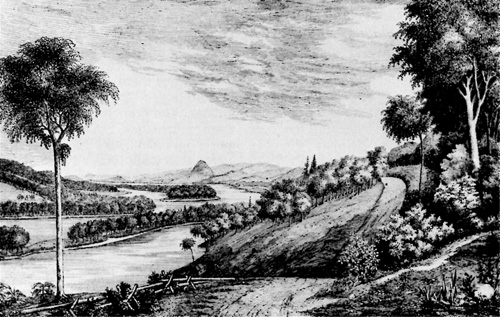
6 "On the River Restigouche, looking down towards the Peak of
Campbellton."
[Canadian Illustrated News, 19 August 1882, p.
120.)
|
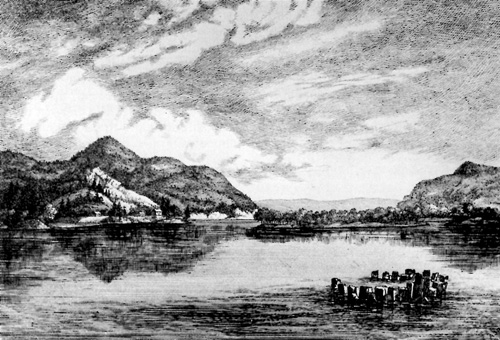
7 "Looking up the Restigouche from Le Petite Rochelle [near Pointe à
Bourdeau]."
[Canadian Illustrated News, 19 August 1882, p. 120.)
|
Having thus burned and destroyed or caused to be destroyed everything
within their reach in complete fulfillment of the aim of the
expedition's singleminded commander, the Repulse, the
Scarborough and the armed schooner swung around at 11 o'clock on
the evening of 8 July and withdrew downstream. The French fleet
destroyed, Byron did not even silence the empty tauntings of the one
remaining enemy position, the Pointe de la Mission battery. After
pausing off Pointe à la Batterie while rum was issued, Byron's squadron
sailed. On 14 July, near Paspébiac, they met Wallis's squadron from
Quebec which had been searching the lower St. Lawrence and the gulf for
the French ships, then continued on their way, four to the Fortress of
Louisbourg and the Repulse to Halifax, "her rigging, masts and
hull much shattered and no stores left at Louisbourg."49
After the unexpected and overwhelming attack of the British, the
French were left to salvage what they could of the situation. Most of
their ships' cargoes had been lost, many men had been
killed,50 and only a few boats were left to cross a large
ocean. When St. Simon returned with Vaudreuil's instructions, the French
had little means with which to implement them.
|

